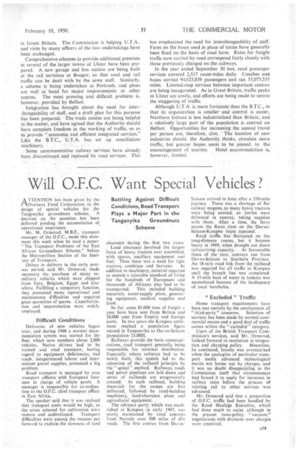Will 0 F.C. Want Special Vehicles ?
Page 57

If you've noticed an error in this article please click here to report it so we can fix it.
Battling Against Difficult Conditions, Road Transport Plays a Major Part in the Tanganyika Groundnuts "Scheme
ATTENTION has been given by .the Overseas Food Corporation _to the design of special vehicles for the Tanganyika groundnuts scheme., A decision on the question has been deferred pending the accumulation of
• operational experience.
Mr, M. Ormerod, M.B.E., transport manager of the 0.F.C., made this statement this week when he read a paper: The Transport Problems of the East African Groundnuts Scheme," before the Metropolitan Section of the Institute. of Transport.
Delays in delivery in the early postwar period, said Mr. Ormerod, made necessary the purchase of many ex' military vehicles which were shipped from Italy, Belgium, Egypt and elsewhere. Fulfilling a temporary function, they presented many operational and maintenance difficulties and required great quantities of spares. Cannibalization and improvisation were widely employed.
Difficult Conditions •
Deliveries of new vehicles began Eater, and during 1948 a normal documentation system was started for the fleet. which now numbers about 2,000 vehicles. Native drivers had to b,e trained and road transport, having regard to equipment deficiencies, bad roads, inexperienced labour and intermittent petrol supplies, presented a big problem. Road transport is managed by area transport officers with' European foremen in charge of vehicle pools. A manager is responsible for co-ordination to the O.F.C. chief transport officer
in East Africa. •
The speaker said that it was realized that transport costs would be high, as the areas selected. for cultivation were
remote and undeveloped. Transport difficulties were among the reasons put forward to explain the slowness of land
clearaneeduring the first two years. Land clearance Involved thelargest force of heavy ,tractors ever assembled, with spares,' ancillary equipment and -fuel. Then there was a need for light tractors, combines and harrows. in addition to machinery, material required to sustain a tolerable standard of living for the hundreds of Europeans and thousands of .Africans also had to be transported. This included building .Materials. water-suppty rplant, ,generating. equipment, medical supplies and food..
So far, some 85,000 tons of freight a year have been sent from Britain and 20,000 tons from Empire and foreign ports. In,two years the Kongwa settlement reached , a population figure second in Tanganyikato' Dar-es-Salaam [population 25,000].
Railways provide the basic communications, road transport generally being respodsible for. terminal distribution. Especially where railways had to be newly built, -this .sy.stern led to the extensionof the railhead Principle by the." spinal" method. Railways, roads 'arid petrol pipelines .are laid down and series of • railheads are progressively Created.. At each 'railhead, building .materials for the' camps are first delivered, followed by road-building 'machinery, • land-clearance plant and
agricultural ectitipthent, ,
'The advance party,' which was established at KOngwa' in early 1947, was partly maintained by road convoys from Nairobi over 500 'miles of dirt roads. The first convoy from Dar-es Salaam arrived in June after a 350-mile journey. There was .a shortage of fiat railway wagons. as many heavy tractors were' being carried, so lorries were delivered in convoy, taking supplies with them.. After a time, the ferry across the Ruvu river on the Dar-esSalaam-Kongwa route capsized.
Road traffic has fluctuated on the long-distance routes, but it became heavy in 1949, when drought cut down
rail-carrving capacity. At favourable times o? the year, convoys run from Dar-es-Salaam to Southern Province. An 18-mile road link from the railhead was required for all traffic to Kongwa until the branch line was completed. A 15-mile haul of water in tankers was necessitated because of the inadequacy of local borehoies.
" Excluded " Traffic
Home transport requirements have been met entirely by the employment of
"third-party" concerns. Selection of services has been made.by normal commercial means and a .good deal of traffic comes within the " excluded ".category.
Users of the British Transport Commission's services, said Mr. Ormerod, looked forward to resolution in integra
tion and charging policy. Meantime. he continued, loyalty was overstraned when the apologists. of particular transport media advanced technological merits not borne out by charges, and it was no doubt disappointing to the Commission itself that circumstances had forced. it to apply for increases in railway rates before the process of relating rail to other' services was advanced.
Orrnerod said that a proportion of O.F.C. traffic had been handled by the Road Haulage Executive, Which had done much to assist, although in the present rates-policy " vacuum.negotiations with divisions over charges
were empirical. •




















































































